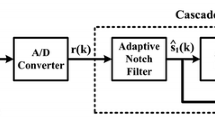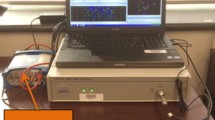Abstract
Interference has destructive impacts on all signals, but due to the weakness of the global positioning system (GPS) signals, even low-power interference has a significant destructive effect. Mitigation of that effect is a challenging issue for GPS receivers. We investigate the performance of the acquisition in the presence of the most effective and common interferences in use, such as single-tone continuous wave interference (CWI), multi-tone CWI, and chirp jamming. Our purpose is not to mitigate or completely remove the interference signal, but by using a signal processing method after the correlation, a receiver can acquire weak signals in the presence of interference with a jammer-to-signal ratio up to 60 dB. The main idea is derived from image processing filters so that by applying proper filters to the values of the cross-ambiguity function in the search space, the interference signal contribution decreases without any need for prior knowledge of its specific characteristics. Accordingly, even weak GPS signals can be easily acquired, and the number of acquired satellites increases significantly compared to the usual anti-jamming methods. Moreover, signals can be acquired even at twice the normal decision threshold value.




















Similar content being viewed by others
References
Abdizadeh M, Curran JT, Lachapelle G (2014) New decision variables for GNSS acquisition in the presence of CW interference. IEEE Trans Aerosp Electron Syst 50(4):2794–2806
Amin MG, Wang C, Lindsey AR (1999) Optimum interference excision in spread spectrum communications using open-loop adaptive filters. IEEE Trans Signal Process 47(7):1966–1976
Babu R, Wang J (2005) Dynamics performance of carrier and code tracking loops in ultra-tight GPS/INS/PL integration. In: 2005 Annual IEEE India conference-Indicon, pp 233–236
Balaei AT, Barnes J, Dempster AG (2005) Characterization of interference effects on GPS signal carrier phase error. In: Proceedings of SSC 2005 spatial intelligence, innovation and praxis, Melbourne, Spatial Science Institute, September, pp 1–9
Balaei AT, Dempster AG, Presti LL (2009) Characterization of the effects of CW and pulse CW interference on the GPS signal quality. IEEE Trans Aerosp Electron Syst 45(4):1418–1431
Borio D (2010) GNSS Acquisition in the presence of continuous wave interference. IEEE Trans Aerosp Electron Syst 46(1):47–60
Borio D, Camoriano L, Presti LL (2008) Impact of GPS acquisition strategy on decision probabilities. IEEE Trans Aerosp Electron Syst 44(3):996–1011
Burger W, Burge MJ (2016) Edge-preserving smoothing filters. In: Digital image processing. Texts in computer science. Springer, London
Chan F, Choi J, Wang J (2005) A robust signal acquisition and tracking architecture with ultra-tight integration of GPS/INS/PL and multiple antenna array. In: International symposium on GPS/GNSS, Hong Kong, pp 8–10
Gao GX, Sgammini M, Lu M, Kubo N (2016) Protecting GNSS receivers from jamming and interference. Proc IEEE 104(6):1327–1338
Gonzalez RC, Woods RE (2006) Digital image processing, 3rd edn. Prentice-Hall, Upper Saddle River
Jiang Z, Ma C, Lachapelle G (2004) Mitigation of narrow band interference on software receivers based on spectrum analysis. University of Calgary, Department of Geomatics Engineering
Kaplan ED, Hegarty CJ (2005) Understanding GPS: principles and applications, 2nd edn. Artech House Publishers, Norwood
Li M, Dempster AG, Balaei AT, Rizos C, Wang F (2011) Switchable beam steering/null steering algorithm for CW interference mitigation in GPS C/A code receivers. IEEE Trans Aerosp Electron Syst 47(3):1564–1579
Lin T, Abdizadeh M, Broumandan A, Wang D, O’Keefe K, Lachapelle G (2011) Interference suppression for high precision navigation using vector-based GNSS software receivers. In: Proceedings of ION GNSS 2011, Institute of Navigation, Portland, Oregon, USA, September 20–23, pp 372–383
Mosavi MR, Shafiee F (2016) Narrowband interference suppression for GPS navigation using neural networks. GPS Solut 20(3):341–351
Mosavi MR, Pashaian M, Rezaei MJ, Mohammadi K (2015) Jamming mitigation in global positioning system receivers using wavelet packet coefficients thresholding. IET Signal Proc 9(5):457–464
Mosavi MR, Rezaei MJ, Pashaian M, Moghaddasi MS (2017) A fast and accurate anti-jamming system based on wavelet packet transform for GPS receivers. GPS Solut 21(2):415–426
Park K, Lee D, Seo J (2018) Dual-polarized GPS antenna array algorithm to adaptively mitigate a large number of interference signals. Aerosp Sci Technol 78:387–396
Petovello MG, Lachapelle G (2006) Comparison of vector-based software receiver implementations with application to ultra-tight GPS/INS integration. In: Proceedings of ION GNSS 2006, Institute of Navigation, Fort Worth, Texas, September 26–29, pp 1790–1799
Razavi A, Gebre-Egziabher D, Akos DM (2008) Carrier loop architectures for tracking weak GPS signals. IEEE Trans Aerosp Electron Syst 44(2):697–710
Rezaei MJ, Abedi M, Mosavi MR (2016) New GPS anti-jamming system based on multiple short-time Fourier transform. IET Radar Sonar Navig 10(4):807–815
Sahmoudi M, Amin MG, Landry R (2008) Acquisition of weak GNSS signals using a new block averaging pre-processing. In: 2008 IEEE/ION position, location and navigation symposium, May 6–8, pp 1362–1372
Sicuranza G (2000) Nonlinear image processing. Elsevier, Amsterdam
Trinkle M, Gray D (2001) GPS interference mitigation; overview and experimental results. In Proceedings of the 5th international symposium on satellite navigation technology and applications, Canberra, Australia, July 24–27, pp 1–14
Ward PW (1994) GPS receiver RF interference monitoring, mitigation, and analysis techniques. Navigation 41(4):367–392
Zhang W, Ghogho M (2012) Computational efficiency improvement for unaided weak GPS signal acquisition. J Navig 65(2):363–375
Author information
Authors and Affiliations
Corresponding author
Additional information
Publisher's Note
Springer Nature remains neutral with regard to jurisdictional claims in published maps and institutional affiliations.
Rights and permissions
About this article
Cite this article
Aghadadashfam, M., Mosavi, M.R. & Rezaei, M.J. A new post-correlation anti-jamming technique for GPS receivers. GPS Solut 24, 89 (2020). https://doi.org/10.1007/s10291-020-01004-y
Received:
Accepted:
Published:
DOI: https://doi.org/10.1007/s10291-020-01004-y




